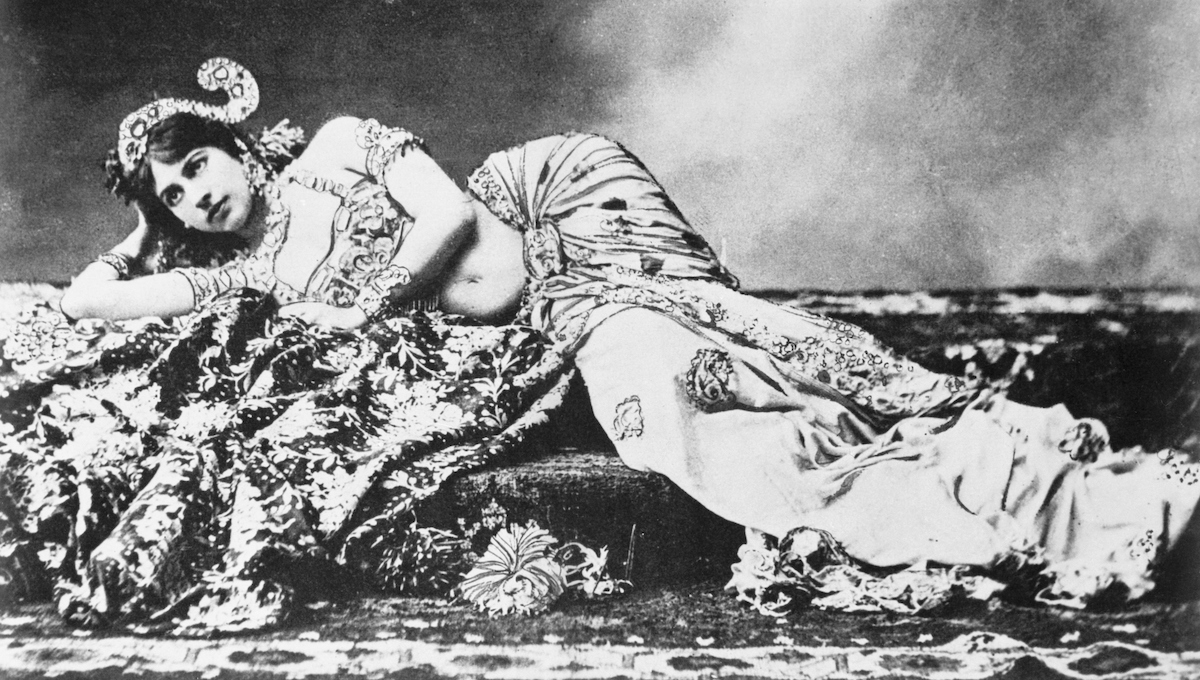
She refused a blindfold and by some accounts even smiled at her executioners. Margaretha Zelle, a.k.a. “Mata Hari,” an exotic dancer and convicted spy, met her end at age 41 at the hands of a firing squad outside Paris 100 years ago on Oct. 15, 1917.
She’s been portrayed as a femme fatale archetype and one of history’s greatest spies, and her life has inspired films, musicals, a ballet and books, including Paulo Coelho’s recent The Spy: A Novel of Mata Hari.
However, some contend that — regarding military matters — she was little more than a gossip with a thing for officers on both sides of the WWI battlefront. In the view of Russell Warren Howe, author of Mata Hari: The True Story, “The legend far surpasses the woman.”
Born in 1876 in the Netherlands, she was the daughter of a once-prosperous hat merchant who went bankrupt. At age 18, she married an officer in the Dutch colonial army. Together they lived at his military post in Indonesia (then called the Dutch East Indies), where they had two children — one of whom died soon after birth — during their unhappy, mutually unfaithful, and at times physically abusive marriage.
Upon heading back to Europe in 1902, the couple separated and ultimately divorced. Migrating to Paris, the divorcee reinvented herself as a striptease dancer who claimed to be of Far Eastern descent. She called herself Mata Hari (“eye of the dawn” in the Malay language).
Starting in 1905, she captivated crowds in Europe’s cultural capitals. Her career lasted about a decade until she lost ground to younger and more athletic imitators. But she still possessed abundant charm and was fluent in several languages, and was able to find success as a courtesan, seducing the wealthy and powerful from multiple nations, including high-ranking government officials.
Because her home country remained neutral during World War I, she was allowed to cross borders with comparatively little hassle. However, her travels and lifestyle would attract attention: Before the War, her behavior might’ve met with mere moral disapproval. But during the War, it also elicited suspicion of espionage.
Among her lovers was Major Arnold Kalle, a German military attaché. Whether he began to regard her as a nuisance or a liability, he sought to dispose of her. So, using a code that he knew the French had already cracked, he transmitted a message easily identifying her as a spy.
Mata Hari was arrested in a luxury Paris hotel in February 1917, and her closed-door trial took place five months later. Though the prosecution blamed her for the deaths of 50,000 French soldiers, no specific evidence or explanation was provided as to how she caused these fatalities.
In fact, “no one ever identified any specific defeat or leak of information that could be blamed on her,” wrote Pat Shipman in Femme Fatale: Love, Lies, and the Unknown Life of Mata Hari, which described her legacy as a “rich mélange of myth and legend that still persist.”
Although her amorous life wasn’t loyal to any particular side, no evidence existed that she provided militarily useful information to anyone.
But by 1917, the French military was war-weary; morale was low and some military divisions had even begun to mutiny. Shipman contends that the Allied side, and the French especially, “needed someone to blame, to punish – to defeat.” So they found a perfect scapegoat in this “immoral foreigner with a sensuous walk who had shamelessly seduced men from all armies.”
On July 25, 1917, the French military government found her guilty of espionage. The Dutch government did not intervene to any significant degree on behalf of its citizen, who was executed after having spent months enduring malnourishment and incarceration in vermin-infested conditions.
The mythmaking began immediately after her date with the firing squad.
Rumors circulated that the French executioners had fired blanks, enabling her to escape. The truth was far less romantic: After she was shot dead, her remains were donated for dissection to the University of Paris medical school. For all the demand her body had previously inspired, nobody wanted it once she had died.
In the view of Julie Wheelwright, author of The Fatal Lover: Mata Hari and the Myth of Women in Espionage, Mata Hari “symbolized women’s danger, their treacherous desires hidden beneath their rallying cry as mothers of the nation or self-sacrificing nurses.”
And so, however dubious her real-life espionage career was, her legacy became that of the quintessential female spy, and her name evoked mystery, seduction and duplicity. Movie portrayals involving such stars as Greta Garbo only added to the Mata Hari legend.
However the public chose to remember her, the German government exculpated Mata Hari in 1930. But the nation that executed her has shown more reluctance to revisit her story: Though some French papers pertaining to her case have been declassified, it remains to be seen whether the future will further her notoriety as a spy or solidify her tragedy as a scapegoat.
More Must-Reads From TIME
- The 100 Most Influential People of 2024
- The Revolution of Yulia Navalnaya
- 6 Compliments That Land Every Time
- What's the Deal With the Bitcoin Halving?
- If You're Dating Right Now , You're Brave: Column
- The AI That Could Heal a Divided Internet
- Fallout Is a Brilliant Model for the Future of Video Game Adaptations
- Want Weekly Recs on What to Watch, Read, and More? Sign Up for Worth Your Time
Contact us at letters@time.com